Firm, Market, and Business Management Report: Canada's Economy
VerifiedAdded on 2020/02/24
|14
|2522
|53
Report
AI Summary
This report provides an in-depth analysis of firm, market, and business management within the context of the Canadian economy. It explores the demand for alcoholic beverages and its relationship with various macroeconomic factors, including immigration, demographic changes, and government policies. The report examines the performance of the Canadian macroeconomic environment, focusing on oil prices, globalization, income distribution, government debt, and unemployment rates. It also investigates the alcoholic beverages industry, analyzing trends in beer, wine, and spirits sales, and the impact of government excise duties. Furthermore, the report delves into Canada's GDP growth, monetary and fiscal policies, inflation, and employment generation, discussing their implications for the economy and the sales of tequila spirits from Mexican companies. The analysis incorporates data from various sources and provides insights into the interplay between economic conditions and business management strategies.
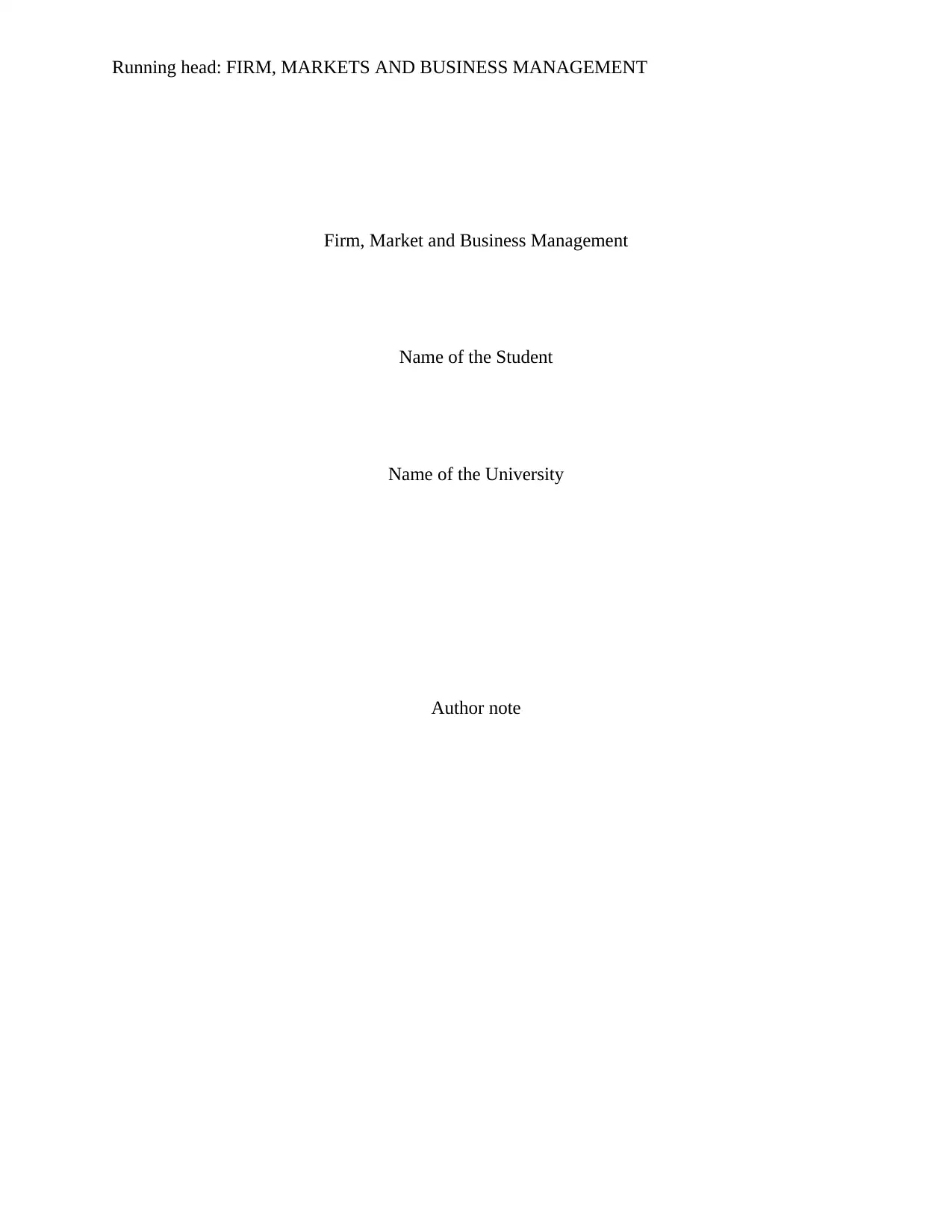
Running head: FIRM, MARKETS AND BUSINESS MANAGEMENT
Firm, Market and Business Management
Name of the Student
Name of the University
Author note
Firm, Market and Business Management
Name of the Student
Name of the University
Author note
Paraphrase This Document
Need a fresh take? Get an instant paraphrase of this document with our AI Paraphraser
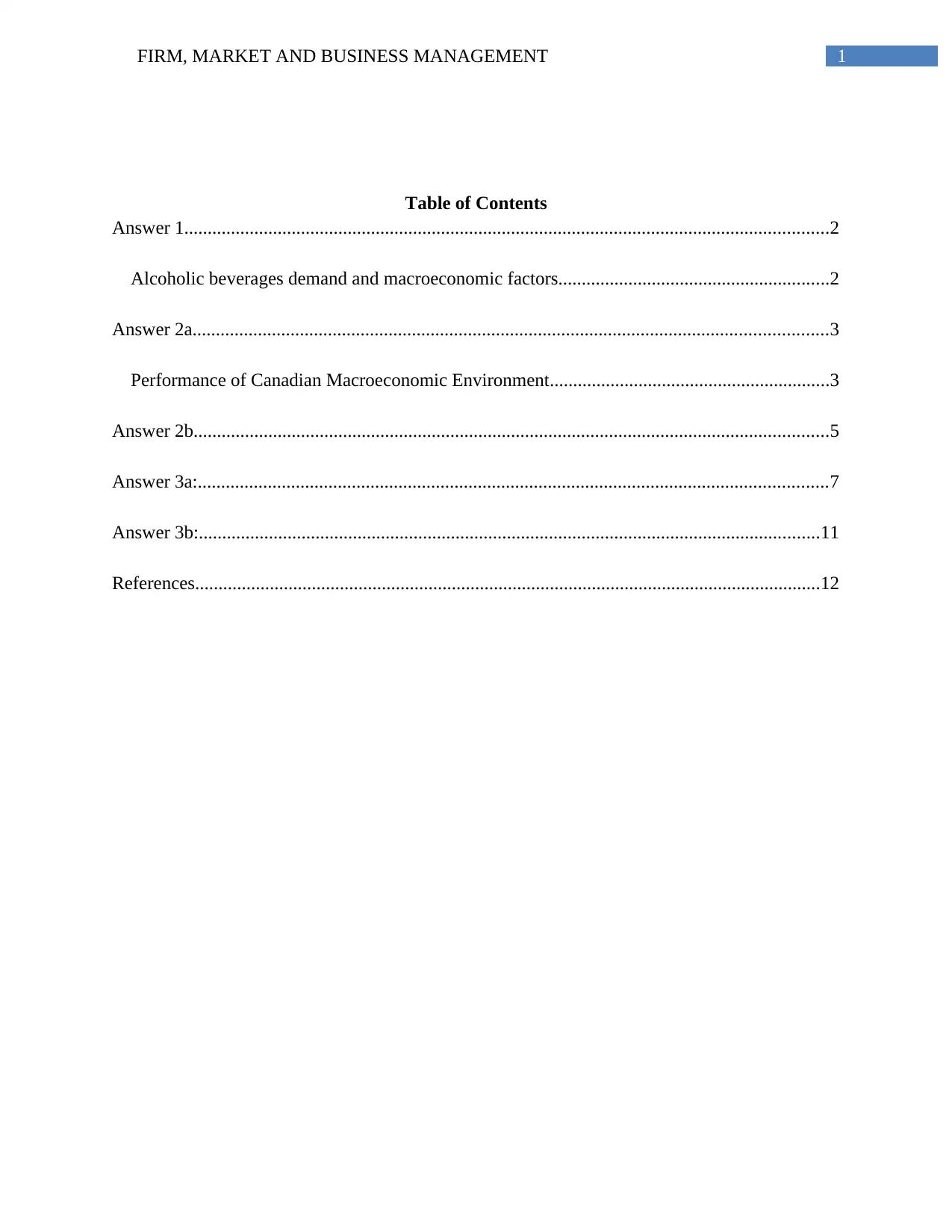
1FIRM, MARKET AND BUSINESS MANAGEMENT
Table of Contents
Answer 1..........................................................................................................................................2
Alcoholic beverages demand and macroeconomic factors..........................................................2
Answer 2a........................................................................................................................................3
Performance of Canadian Macroeconomic Environment............................................................3
Answer 2b........................................................................................................................................5
Answer 3a:.......................................................................................................................................7
Answer 3b:.....................................................................................................................................11
References......................................................................................................................................12
Table of Contents
Answer 1..........................................................................................................................................2
Alcoholic beverages demand and macroeconomic factors..........................................................2
Answer 2a........................................................................................................................................3
Performance of Canadian Macroeconomic Environment............................................................3
Answer 2b........................................................................................................................................5
Answer 3a:.......................................................................................................................................7
Answer 3b:.....................................................................................................................................11
References......................................................................................................................................12
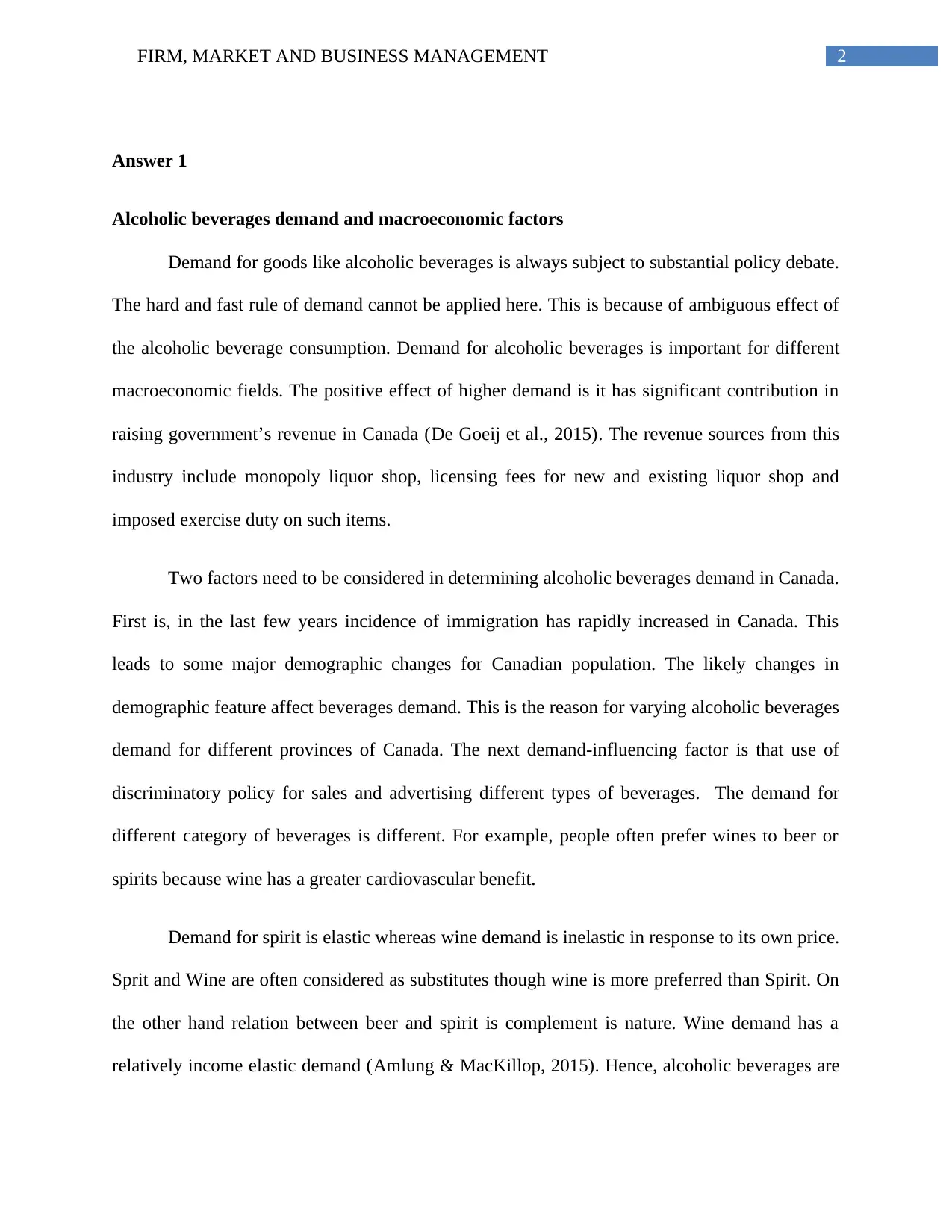
2FIRM, MARKET AND BUSINESS MANAGEMENT
Answer 1
Alcoholic beverages demand and macroeconomic factors
Demand for goods like alcoholic beverages is always subject to substantial policy debate.
The hard and fast rule of demand cannot be applied here. This is because of ambiguous effect of
the alcoholic beverage consumption. Demand for alcoholic beverages is important for different
macroeconomic fields. The positive effect of higher demand is it has significant contribution in
raising government’s revenue in Canada (De Goeij et al., 2015). The revenue sources from this
industry include monopoly liquor shop, licensing fees for new and existing liquor shop and
imposed exercise duty on such items.
Two factors need to be considered in determining alcoholic beverages demand in Canada.
First is, in the last few years incidence of immigration has rapidly increased in Canada. This
leads to some major demographic changes for Canadian population. The likely changes in
demographic feature affect beverages demand. This is the reason for varying alcoholic beverages
demand for different provinces of Canada. The next demand-influencing factor is that use of
discriminatory policy for sales and advertising different types of beverages. The demand for
different category of beverages is different. For example, people often prefer wines to beer or
spirits because wine has a greater cardiovascular benefit.
Demand for spirit is elastic whereas wine demand is inelastic in response to its own price.
Sprit and Wine are often considered as substitutes though wine is more preferred than Spirit. On
the other hand relation between beer and spirit is complement is nature. Wine demand has a
relatively income elastic demand (Amlung & MacKillop, 2015). Hence, alcoholic beverages are
Answer 1
Alcoholic beverages demand and macroeconomic factors
Demand for goods like alcoholic beverages is always subject to substantial policy debate.
The hard and fast rule of demand cannot be applied here. This is because of ambiguous effect of
the alcoholic beverage consumption. Demand for alcoholic beverages is important for different
macroeconomic fields. The positive effect of higher demand is it has significant contribution in
raising government’s revenue in Canada (De Goeij et al., 2015). The revenue sources from this
industry include monopoly liquor shop, licensing fees for new and existing liquor shop and
imposed exercise duty on such items.
Two factors need to be considered in determining alcoholic beverages demand in Canada.
First is, in the last few years incidence of immigration has rapidly increased in Canada. This
leads to some major demographic changes for Canadian population. The likely changes in
demographic feature affect beverages demand. This is the reason for varying alcoholic beverages
demand for different provinces of Canada. The next demand-influencing factor is that use of
discriminatory policy for sales and advertising different types of beverages. The demand for
different category of beverages is different. For example, people often prefer wines to beer or
spirits because wine has a greater cardiovascular benefit.
Demand for spirit is elastic whereas wine demand is inelastic in response to its own price.
Sprit and Wine are often considered as substitutes though wine is more preferred than Spirit. On
the other hand relation between beer and spirit is complement is nature. Wine demand has a
relatively income elastic demand (Amlung & MacKillop, 2015). Hence, alcoholic beverages are
⊘ This is a preview!⊘
Do you want full access?
Subscribe today to unlock all pages.

Trusted by 1+ million students worldwide
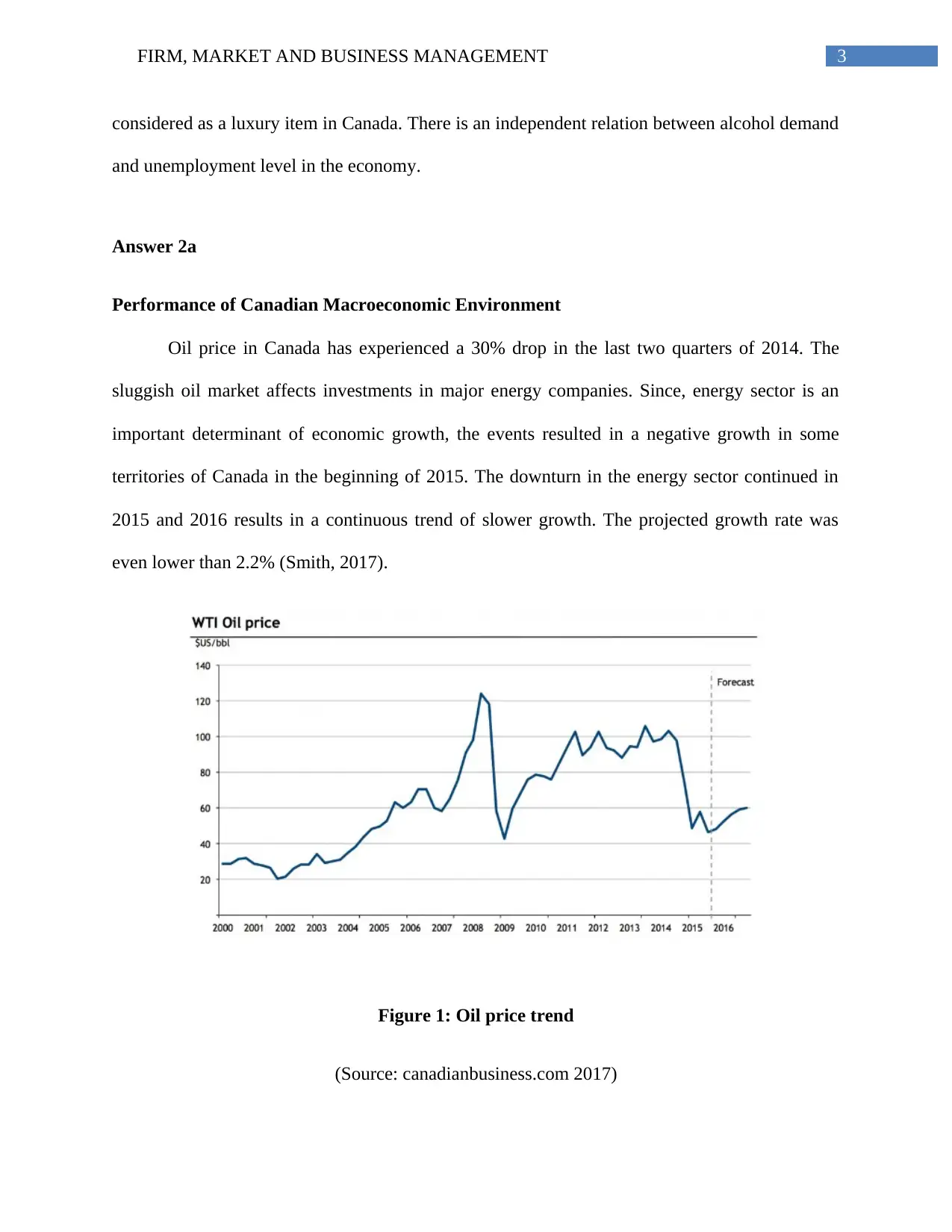
3FIRM, MARKET AND BUSINESS MANAGEMENT
considered as a luxury item in Canada. There is an independent relation between alcohol demand
and unemployment level in the economy.
Answer 2a
Performance of Canadian Macroeconomic Environment
Oil price in Canada has experienced a 30% drop in the last two quarters of 2014. The
sluggish oil market affects investments in major energy companies. Since, energy sector is an
important determinant of economic growth, the events resulted in a negative growth in some
territories of Canada in the beginning of 2015. The downturn in the energy sector continued in
2015 and 2016 results in a continuous trend of slower growth. The projected growth rate was
even lower than 2.2% (Smith, 2017).
Figure 1: Oil price trend
(Source: canadianbusiness.com 2017)
considered as a luxury item in Canada. There is an independent relation between alcohol demand
and unemployment level in the economy.
Answer 2a
Performance of Canadian Macroeconomic Environment
Oil price in Canada has experienced a 30% drop in the last two quarters of 2014. The
sluggish oil market affects investments in major energy companies. Since, energy sector is an
important determinant of economic growth, the events resulted in a negative growth in some
territories of Canada in the beginning of 2015. The downturn in the energy sector continued in
2015 and 2016 results in a continuous trend of slower growth. The projected growth rate was
even lower than 2.2% (Smith, 2017).
Figure 1: Oil price trend
(Source: canadianbusiness.com 2017)
Paraphrase This Document
Need a fresh take? Get an instant paraphrase of this document with our AI Paraphraser
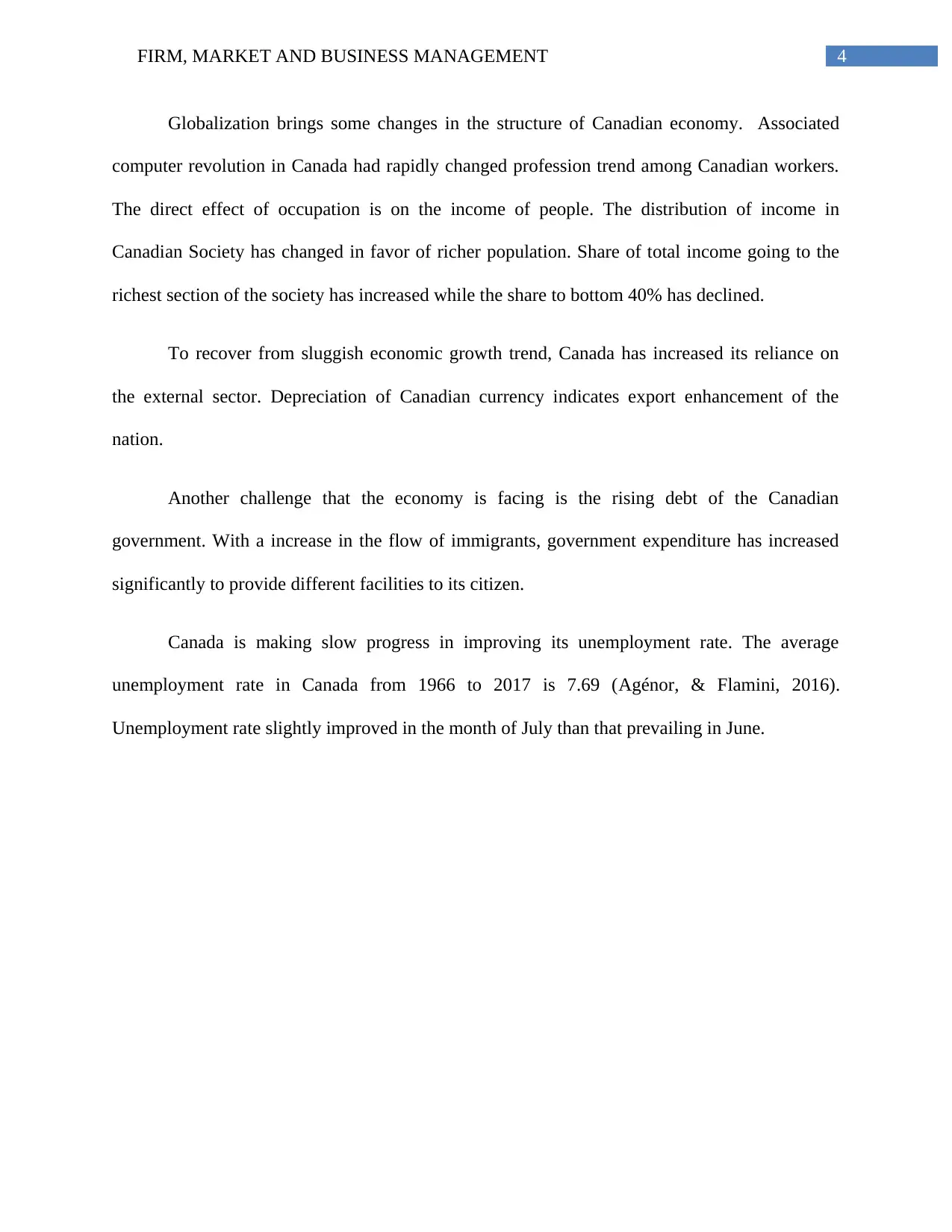
4FIRM, MARKET AND BUSINESS MANAGEMENT
Globalization brings some changes in the structure of Canadian economy. Associated
computer revolution in Canada had rapidly changed profession trend among Canadian workers.
The direct effect of occupation is on the income of people. The distribution of income in
Canadian Society has changed in favor of richer population. Share of total income going to the
richest section of the society has increased while the share to bottom 40% has declined.
To recover from sluggish economic growth trend, Canada has increased its reliance on
the external sector. Depreciation of Canadian currency indicates export enhancement of the
nation.
Another challenge that the economy is facing is the rising debt of the Canadian
government. With a increase in the flow of immigrants, government expenditure has increased
significantly to provide different facilities to its citizen.
Canada is making slow progress in improving its unemployment rate. The average
unemployment rate in Canada from 1966 to 2017 is 7.69 (Agénor, & Flamini, 2016).
Unemployment rate slightly improved in the month of July than that prevailing in June.
Globalization brings some changes in the structure of Canadian economy. Associated
computer revolution in Canada had rapidly changed profession trend among Canadian workers.
The direct effect of occupation is on the income of people. The distribution of income in
Canadian Society has changed in favor of richer population. Share of total income going to the
richest section of the society has increased while the share to bottom 40% has declined.
To recover from sluggish economic growth trend, Canada has increased its reliance on
the external sector. Depreciation of Canadian currency indicates export enhancement of the
nation.
Another challenge that the economy is facing is the rising debt of the Canadian
government. With a increase in the flow of immigrants, government expenditure has increased
significantly to provide different facilities to its citizen.
Canada is making slow progress in improving its unemployment rate. The average
unemployment rate in Canada from 1966 to 2017 is 7.69 (Agénor, & Flamini, 2016).
Unemployment rate slightly improved in the month of July than that prevailing in June.
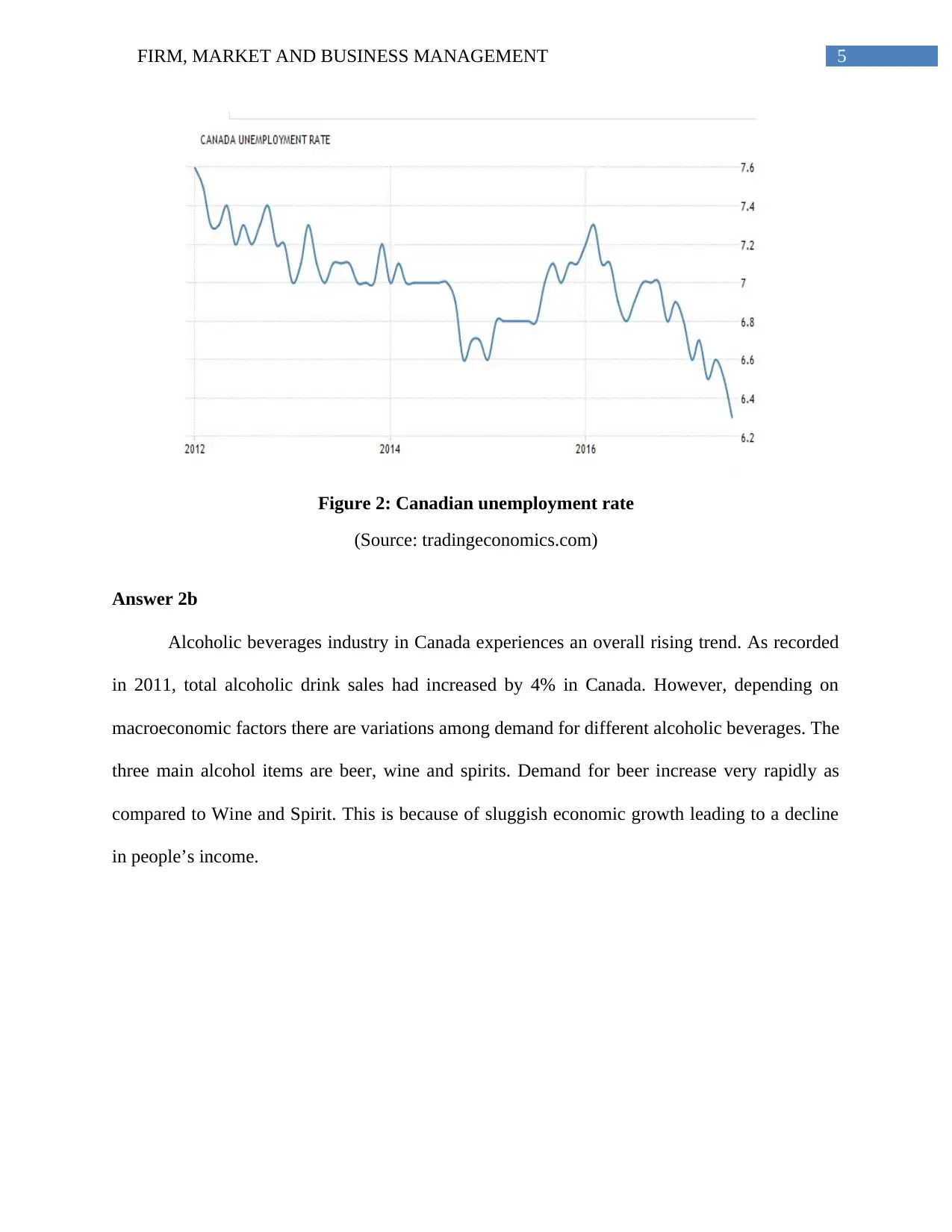
5FIRM, MARKET AND BUSINESS MANAGEMENT
Figure 2: Canadian unemployment rate
(Source: tradingeconomics.com)
Answer 2b
Alcoholic beverages industry in Canada experiences an overall rising trend. As recorded
in 2011, total alcoholic drink sales had increased by 4% in Canada. However, depending on
macroeconomic factors there are variations among demand for different alcoholic beverages. The
three main alcohol items are beer, wine and spirits. Demand for beer increase very rapidly as
compared to Wine and Spirit. This is because of sluggish economic growth leading to a decline
in people’s income.
Figure 2: Canadian unemployment rate
(Source: tradingeconomics.com)
Answer 2b
Alcoholic beverages industry in Canada experiences an overall rising trend. As recorded
in 2011, total alcoholic drink sales had increased by 4% in Canada. However, depending on
macroeconomic factors there are variations among demand for different alcoholic beverages. The
three main alcohol items are beer, wine and spirits. Demand for beer increase very rapidly as
compared to Wine and Spirit. This is because of sluggish economic growth leading to a decline
in people’s income.
⊘ This is a preview!⊘
Do you want full access?
Subscribe today to unlock all pages.

Trusted by 1+ million students worldwide
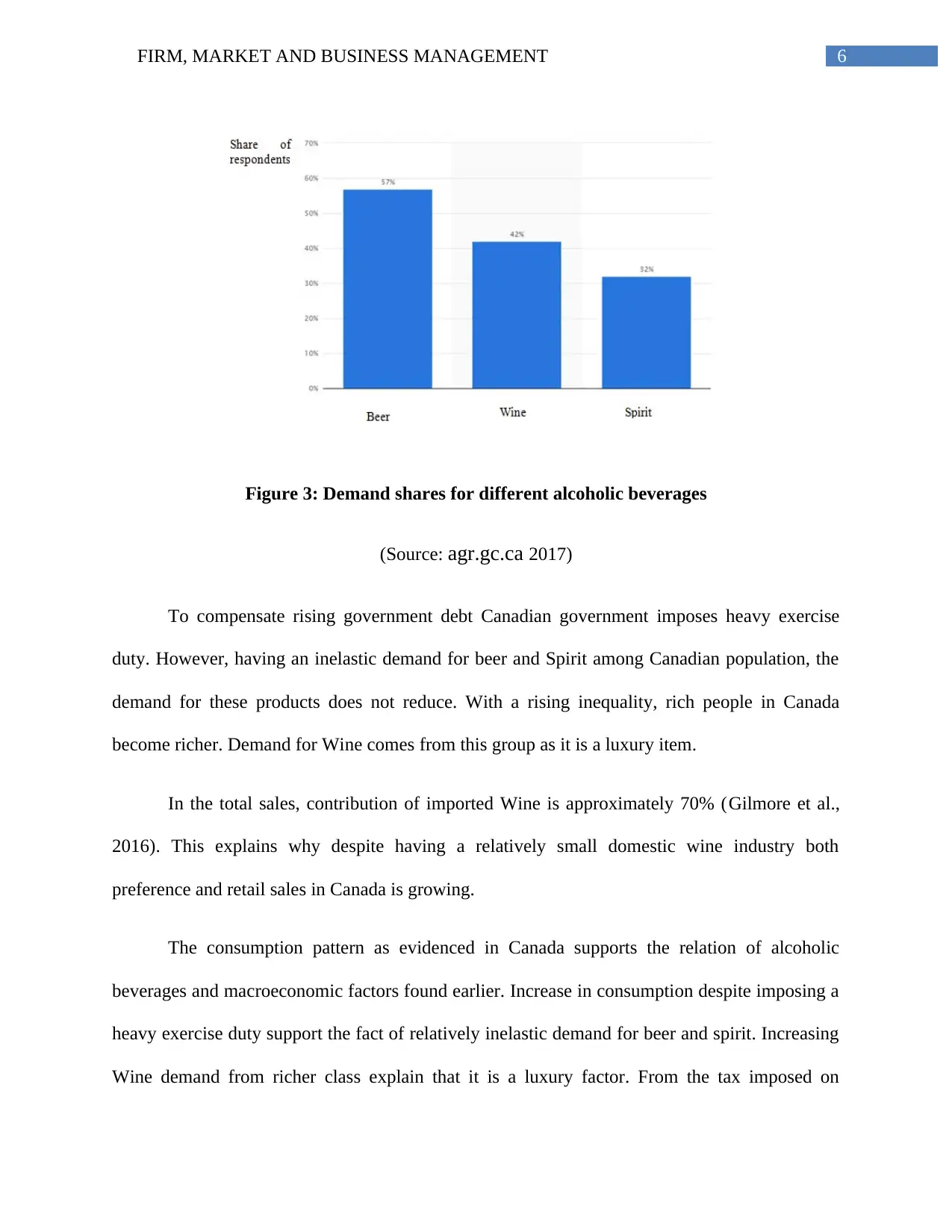
6FIRM, MARKET AND BUSINESS MANAGEMENT
Figure 3: Demand shares for different alcoholic beverages
(Source: agr.gc.ca 2017)
To compensate rising government debt Canadian government imposes heavy exercise
duty. However, having an inelastic demand for beer and Spirit among Canadian population, the
demand for these products does not reduce. With a rising inequality, rich people in Canada
become richer. Demand for Wine comes from this group as it is a luxury item.
In the total sales, contribution of imported Wine is approximately 70% (Gilmore et al.,
2016). This explains why despite having a relatively small domestic wine industry both
preference and retail sales in Canada is growing.
The consumption pattern as evidenced in Canada supports the relation of alcoholic
beverages and macroeconomic factors found earlier. Increase in consumption despite imposing a
heavy exercise duty support the fact of relatively inelastic demand for beer and spirit. Increasing
Wine demand from richer class explain that it is a luxury factor. From the tax imposed on
Figure 3: Demand shares for different alcoholic beverages
(Source: agr.gc.ca 2017)
To compensate rising government debt Canadian government imposes heavy exercise
duty. However, having an inelastic demand for beer and Spirit among Canadian population, the
demand for these products does not reduce. With a rising inequality, rich people in Canada
become richer. Demand for Wine comes from this group as it is a luxury item.
In the total sales, contribution of imported Wine is approximately 70% (Gilmore et al.,
2016). This explains why despite having a relatively small domestic wine industry both
preference and retail sales in Canada is growing.
The consumption pattern as evidenced in Canada supports the relation of alcoholic
beverages and macroeconomic factors found earlier. Increase in consumption despite imposing a
heavy exercise duty support the fact of relatively inelastic demand for beer and spirit. Increasing
Wine demand from richer class explain that it is a luxury factor. From the tax imposed on
Paraphrase This Document
Need a fresh take? Get an instant paraphrase of this document with our AI Paraphraser
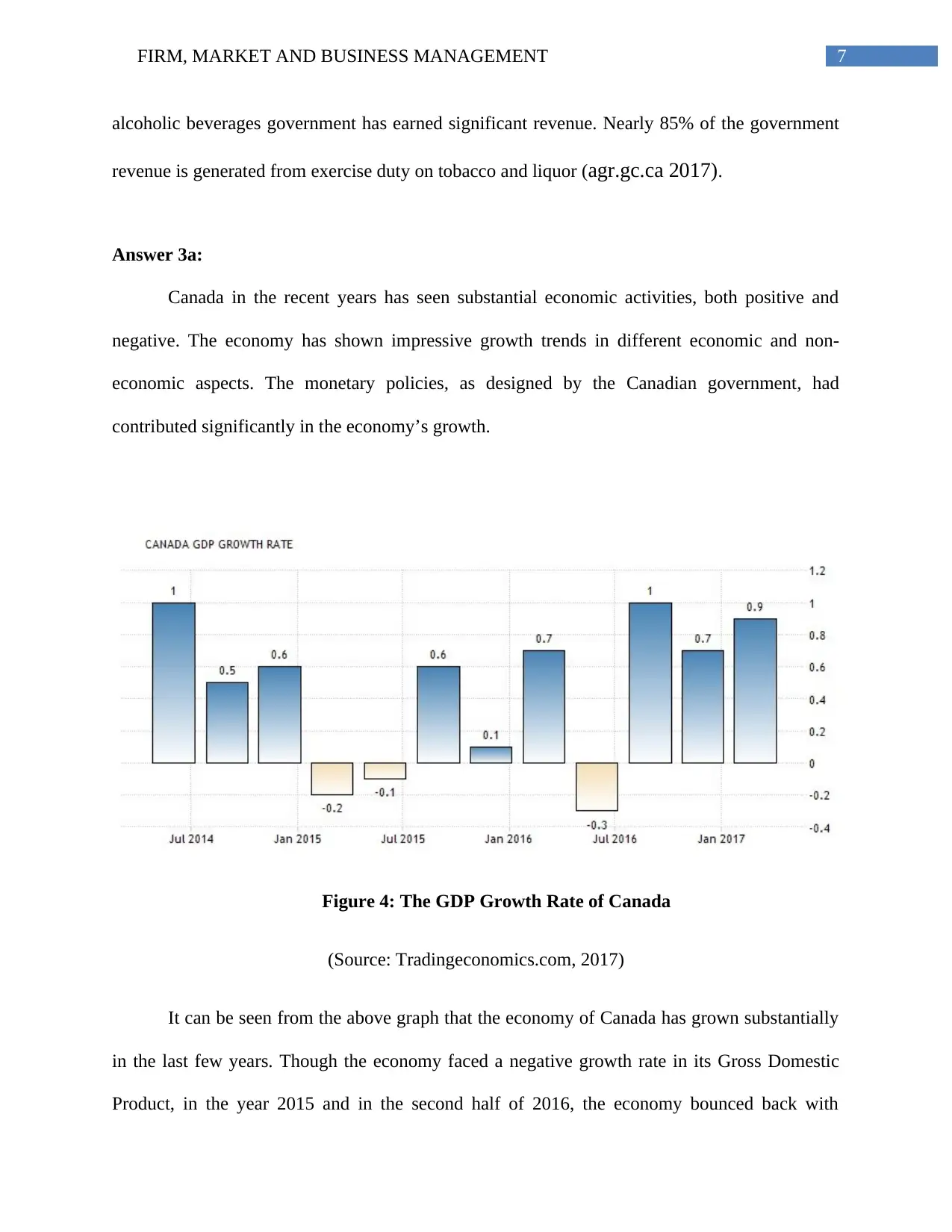
7FIRM, MARKET AND BUSINESS MANAGEMENT
alcoholic beverages government has earned significant revenue. Nearly 85% of the government
revenue is generated from exercise duty on tobacco and liquor (agr.gc.ca 2017).
Answer 3a:
Canada in the recent years has seen substantial economic activities, both positive and
negative. The economy has shown impressive growth trends in different economic and non-
economic aspects. The monetary policies, as designed by the Canadian government, had
contributed significantly in the economy’s growth.
Figure 4: The GDP Growth Rate of Canada
(Source: Tradingeconomics.com, 2017)
It can be seen from the above graph that the economy of Canada has grown substantially
in the last few years. Though the economy faced a negative growth rate in its Gross Domestic
Product, in the year 2015 and in the second half of 2016, the economy bounced back with
alcoholic beverages government has earned significant revenue. Nearly 85% of the government
revenue is generated from exercise duty on tobacco and liquor (agr.gc.ca 2017).
Answer 3a:
Canada in the recent years has seen substantial economic activities, both positive and
negative. The economy has shown impressive growth trends in different economic and non-
economic aspects. The monetary policies, as designed by the Canadian government, had
contributed significantly in the economy’s growth.
Figure 4: The GDP Growth Rate of Canada
(Source: Tradingeconomics.com, 2017)
It can be seen from the above graph that the economy of Canada has grown substantially
in the last few years. Though the economy faced a negative growth rate in its Gross Domestic
Product, in the year 2015 and in the second half of 2016, the economy bounced back with
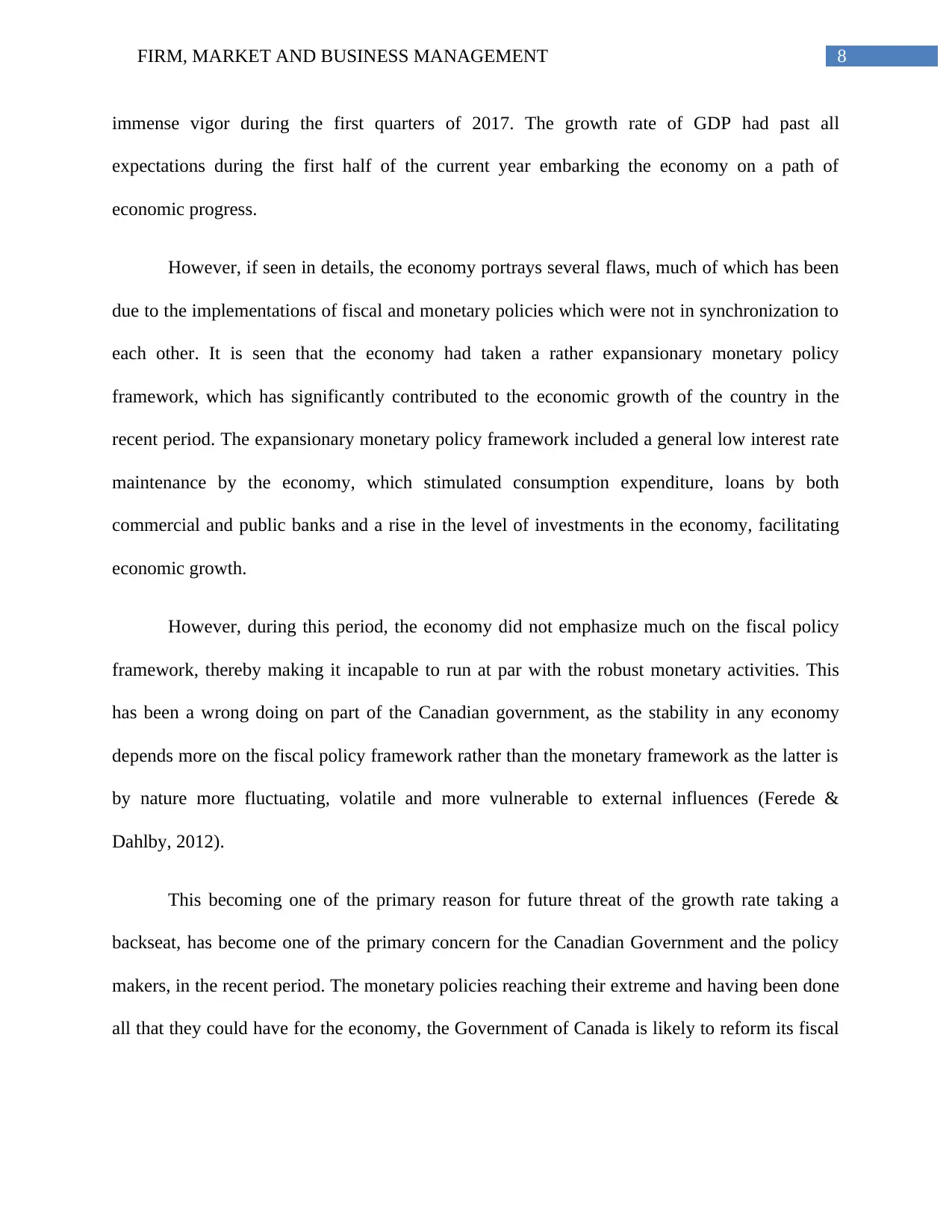
8FIRM, MARKET AND BUSINESS MANAGEMENT
immense vigor during the first quarters of 2017. The growth rate of GDP had past all
expectations during the first half of the current year embarking the economy on a path of
economic progress.
However, if seen in details, the economy portrays several flaws, much of which has been
due to the implementations of fiscal and monetary policies which were not in synchronization to
each other. It is seen that the economy had taken a rather expansionary monetary policy
framework, which has significantly contributed to the economic growth of the country in the
recent period. The expansionary monetary policy framework included a general low interest rate
maintenance by the economy, which stimulated consumption expenditure, loans by both
commercial and public banks and a rise in the level of investments in the economy, facilitating
economic growth.
However, during this period, the economy did not emphasize much on the fiscal policy
framework, thereby making it incapable to run at par with the robust monetary activities. This
has been a wrong doing on part of the Canadian government, as the stability in any economy
depends more on the fiscal policy framework rather than the monetary framework as the latter is
by nature more fluctuating, volatile and more vulnerable to external influences (Ferede &
Dahlby, 2012).
This becoming one of the primary reason for future threat of the growth rate taking a
backseat, has become one of the primary concern for the Canadian Government and the policy
makers, in the recent period. The monetary policies reaching their extreme and having been done
all that they could have for the economy, the Government of Canada is likely to reform its fiscal
immense vigor during the first quarters of 2017. The growth rate of GDP had past all
expectations during the first half of the current year embarking the economy on a path of
economic progress.
However, if seen in details, the economy portrays several flaws, much of which has been
due to the implementations of fiscal and monetary policies which were not in synchronization to
each other. It is seen that the economy had taken a rather expansionary monetary policy
framework, which has significantly contributed to the economic growth of the country in the
recent period. The expansionary monetary policy framework included a general low interest rate
maintenance by the economy, which stimulated consumption expenditure, loans by both
commercial and public banks and a rise in the level of investments in the economy, facilitating
economic growth.
However, during this period, the economy did not emphasize much on the fiscal policy
framework, thereby making it incapable to run at par with the robust monetary activities. This
has been a wrong doing on part of the Canadian government, as the stability in any economy
depends more on the fiscal policy framework rather than the monetary framework as the latter is
by nature more fluctuating, volatile and more vulnerable to external influences (Ferede &
Dahlby, 2012).
This becoming one of the primary reason for future threat of the growth rate taking a
backseat, has become one of the primary concern for the Canadian Government and the policy
makers, in the recent period. The monetary policies reaching their extreme and having been done
all that they could have for the economy, the Government of Canada is likely to reform its fiscal
⊘ This is a preview!⊘
Do you want full access?
Subscribe today to unlock all pages.

Trusted by 1+ million students worldwide
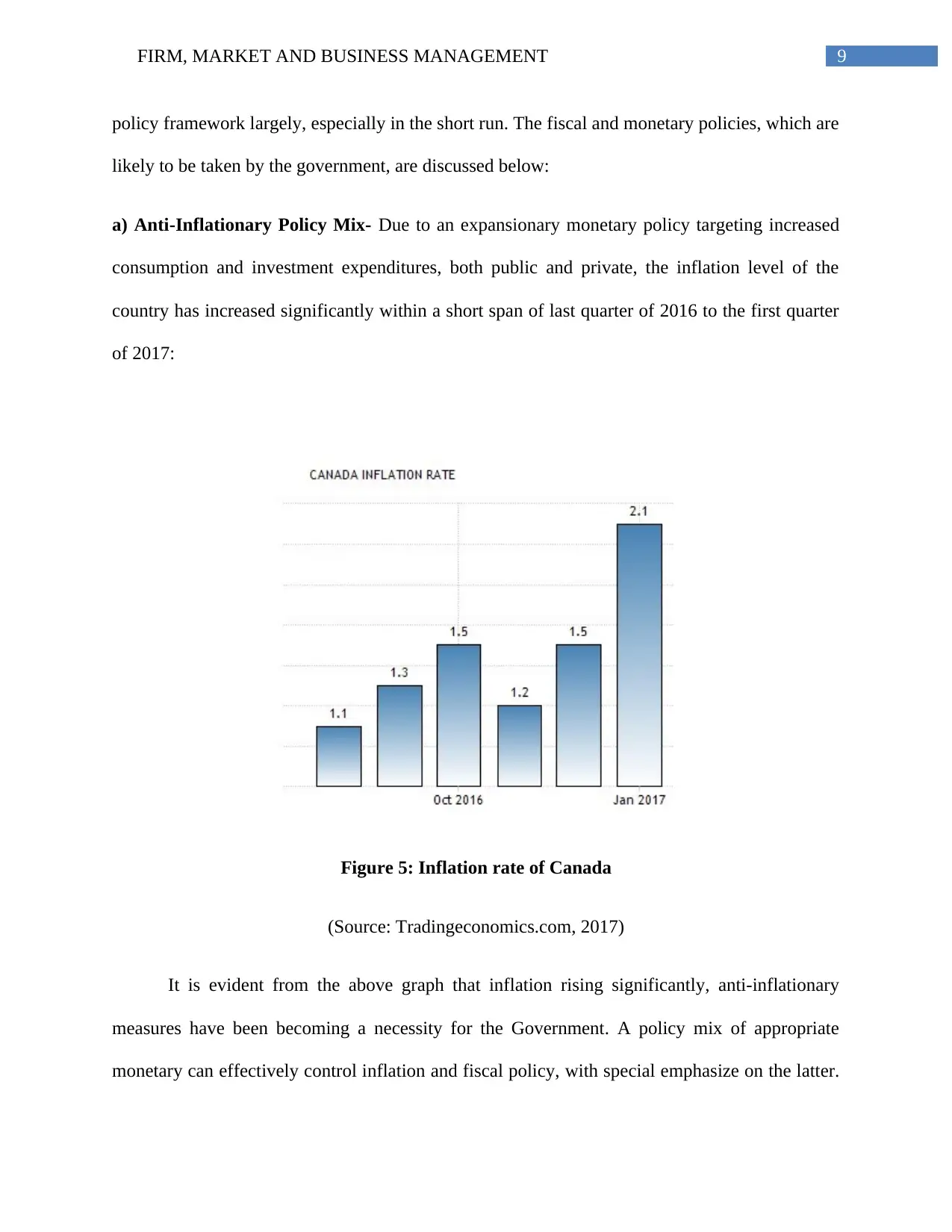
9FIRM, MARKET AND BUSINESS MANAGEMENT
policy framework largely, especially in the short run. The fiscal and monetary policies, which are
likely to be taken by the government, are discussed below:
a) Anti-Inflationary Policy Mix- Due to an expansionary monetary policy targeting increased
consumption and investment expenditures, both public and private, the inflation level of the
country has increased significantly within a short span of last quarter of 2016 to the first quarter
of 2017:
Figure 5: Inflation rate of Canada
(Source: Tradingeconomics.com, 2017)
It is evident from the above graph that inflation rising significantly, anti-inflationary
measures have been becoming a necessity for the Government. A policy mix of appropriate
monetary can effectively control inflation and fiscal policy, with special emphasize on the latter.
policy framework largely, especially in the short run. The fiscal and monetary policies, which are
likely to be taken by the government, are discussed below:
a) Anti-Inflationary Policy Mix- Due to an expansionary monetary policy targeting increased
consumption and investment expenditures, both public and private, the inflation level of the
country has increased significantly within a short span of last quarter of 2016 to the first quarter
of 2017:
Figure 5: Inflation rate of Canada
(Source: Tradingeconomics.com, 2017)
It is evident from the above graph that inflation rising significantly, anti-inflationary
measures have been becoming a necessity for the Government. A policy mix of appropriate
monetary can effectively control inflation and fiscal policy, with special emphasize on the latter.
Paraphrase This Document
Need a fresh take? Get an instant paraphrase of this document with our AI Paraphraser
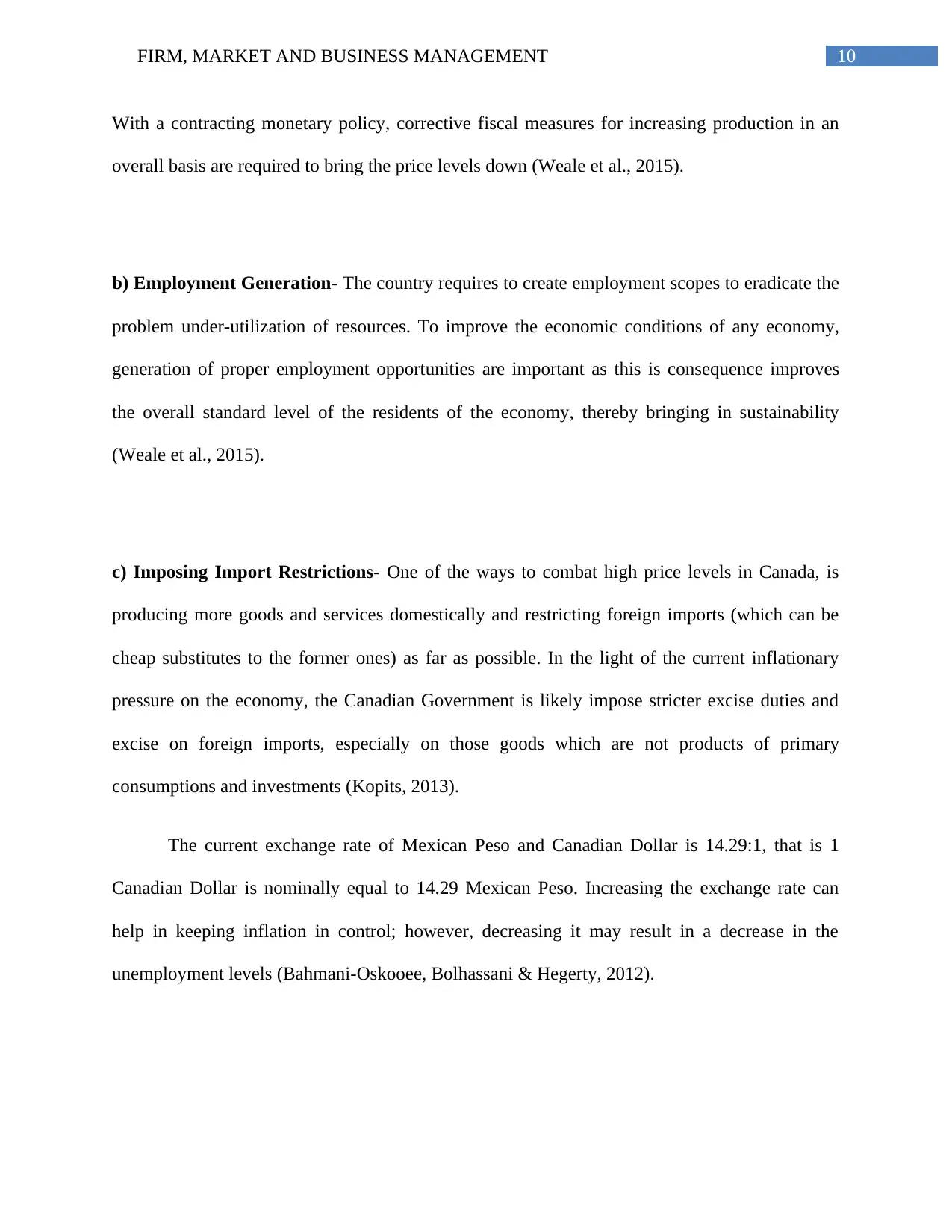
10FIRM, MARKET AND BUSINESS MANAGEMENT
With a contracting monetary policy, corrective fiscal measures for increasing production in an
overall basis are required to bring the price levels down (Weale et al., 2015).
b) Employment Generation- The country requires to create employment scopes to eradicate the
problem under-utilization of resources. To improve the economic conditions of any economy,
generation of proper employment opportunities are important as this is consequence improves
the overall standard level of the residents of the economy, thereby bringing in sustainability
(Weale et al., 2015).
c) Imposing Import Restrictions- One of the ways to combat high price levels in Canada, is
producing more goods and services domestically and restricting foreign imports (which can be
cheap substitutes to the former ones) as far as possible. In the light of the current inflationary
pressure on the economy, the Canadian Government is likely impose stricter excise duties and
excise on foreign imports, especially on those goods which are not products of primary
consumptions and investments (Kopits, 2013).
The current exchange rate of Mexican Peso and Canadian Dollar is 14.29:1, that is 1
Canadian Dollar is nominally equal to 14.29 Mexican Peso. Increasing the exchange rate can
help in keeping inflation in control; however, decreasing it may result in a decrease in the
unemployment levels (Bahmani-Oskooee, Bolhassani & Hegerty, 2012).
With a contracting monetary policy, corrective fiscal measures for increasing production in an
overall basis are required to bring the price levels down (Weale et al., 2015).
b) Employment Generation- The country requires to create employment scopes to eradicate the
problem under-utilization of resources. To improve the economic conditions of any economy,
generation of proper employment opportunities are important as this is consequence improves
the overall standard level of the residents of the economy, thereby bringing in sustainability
(Weale et al., 2015).
c) Imposing Import Restrictions- One of the ways to combat high price levels in Canada, is
producing more goods and services domestically and restricting foreign imports (which can be
cheap substitutes to the former ones) as far as possible. In the light of the current inflationary
pressure on the economy, the Canadian Government is likely impose stricter excise duties and
excise on foreign imports, especially on those goods which are not products of primary
consumptions and investments (Kopits, 2013).
The current exchange rate of Mexican Peso and Canadian Dollar is 14.29:1, that is 1
Canadian Dollar is nominally equal to 14.29 Mexican Peso. Increasing the exchange rate can
help in keeping inflation in control; however, decreasing it may result in a decrease in the
unemployment levels (Bahmani-Oskooee, Bolhassani & Hegerty, 2012).
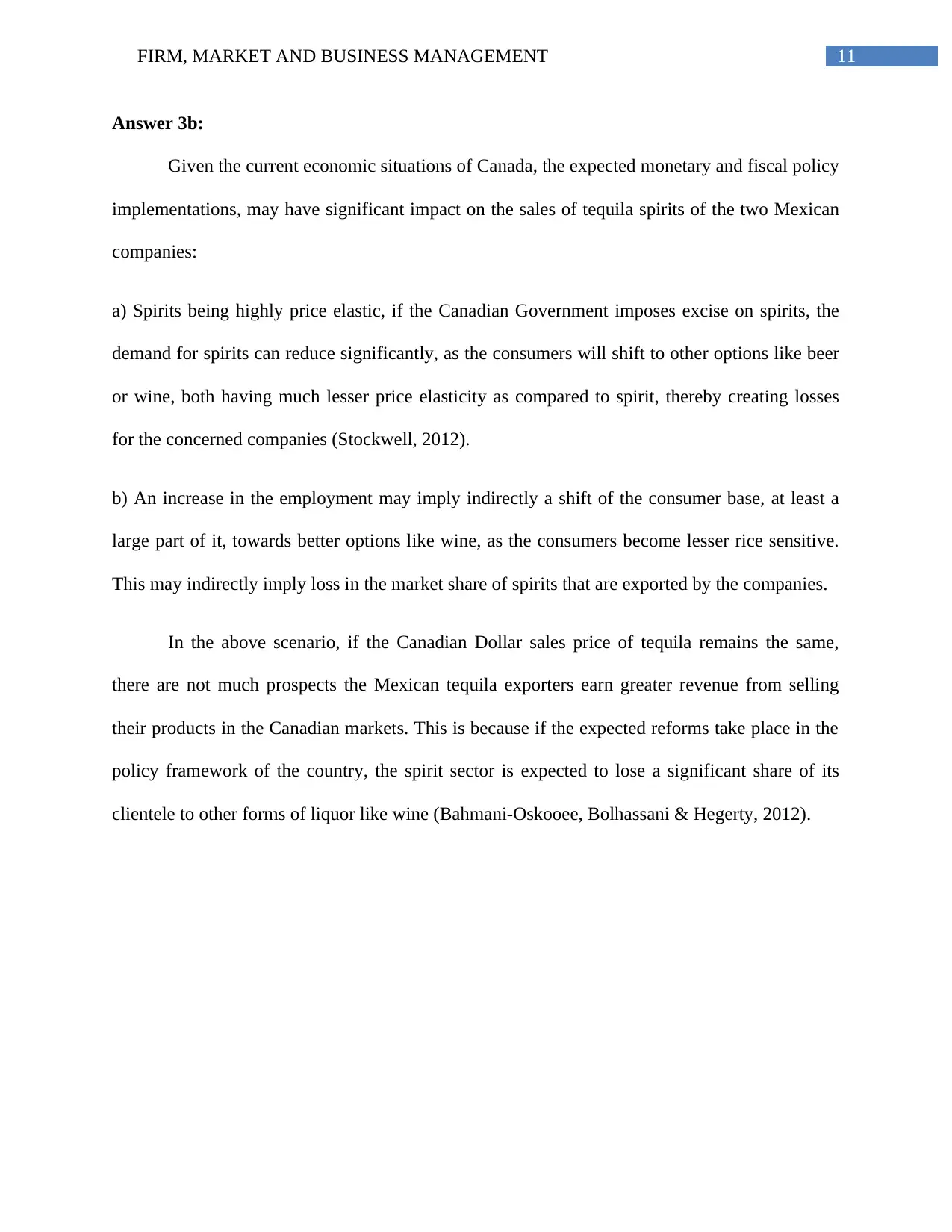
11FIRM, MARKET AND BUSINESS MANAGEMENT
Answer 3b:
Given the current economic situations of Canada, the expected monetary and fiscal policy
implementations, may have significant impact on the sales of tequila spirits of the two Mexican
companies:
a) Spirits being highly price elastic, if the Canadian Government imposes excise on spirits, the
demand for spirits can reduce significantly, as the consumers will shift to other options like beer
or wine, both having much lesser price elasticity as compared to spirit, thereby creating losses
for the concerned companies (Stockwell, 2012).
b) An increase in the employment may imply indirectly a shift of the consumer base, at least a
large part of it, towards better options like wine, as the consumers become lesser rice sensitive.
This may indirectly imply loss in the market share of spirits that are exported by the companies.
In the above scenario, if the Canadian Dollar sales price of tequila remains the same,
there are not much prospects the Mexican tequila exporters earn greater revenue from selling
their products in the Canadian markets. This is because if the expected reforms take place in the
policy framework of the country, the spirit sector is expected to lose a significant share of its
clientele to other forms of liquor like wine (Bahmani-Oskooee, Bolhassani & Hegerty, 2012).
Answer 3b:
Given the current economic situations of Canada, the expected monetary and fiscal policy
implementations, may have significant impact on the sales of tequila spirits of the two Mexican
companies:
a) Spirits being highly price elastic, if the Canadian Government imposes excise on spirits, the
demand for spirits can reduce significantly, as the consumers will shift to other options like beer
or wine, both having much lesser price elasticity as compared to spirit, thereby creating losses
for the concerned companies (Stockwell, 2012).
b) An increase in the employment may imply indirectly a shift of the consumer base, at least a
large part of it, towards better options like wine, as the consumers become lesser rice sensitive.
This may indirectly imply loss in the market share of spirits that are exported by the companies.
In the above scenario, if the Canadian Dollar sales price of tequila remains the same,
there are not much prospects the Mexican tequila exporters earn greater revenue from selling
their products in the Canadian markets. This is because if the expected reforms take place in the
policy framework of the country, the spirit sector is expected to lose a significant share of its
clientele to other forms of liquor like wine (Bahmani-Oskooee, Bolhassani & Hegerty, 2012).
⊘ This is a preview!⊘
Do you want full access?
Subscribe today to unlock all pages.

Trusted by 1+ million students worldwide
1 out of 14
Your All-in-One AI-Powered Toolkit for Academic Success.
+13062052269
info@desklib.com
Available 24*7 on WhatsApp / Email
![[object Object]](/_next/static/media/star-bottom.7253800d.svg)
Unlock your academic potential
Copyright © 2020–2025 A2Z Services. All Rights Reserved. Developed and managed by ZUCOL.

